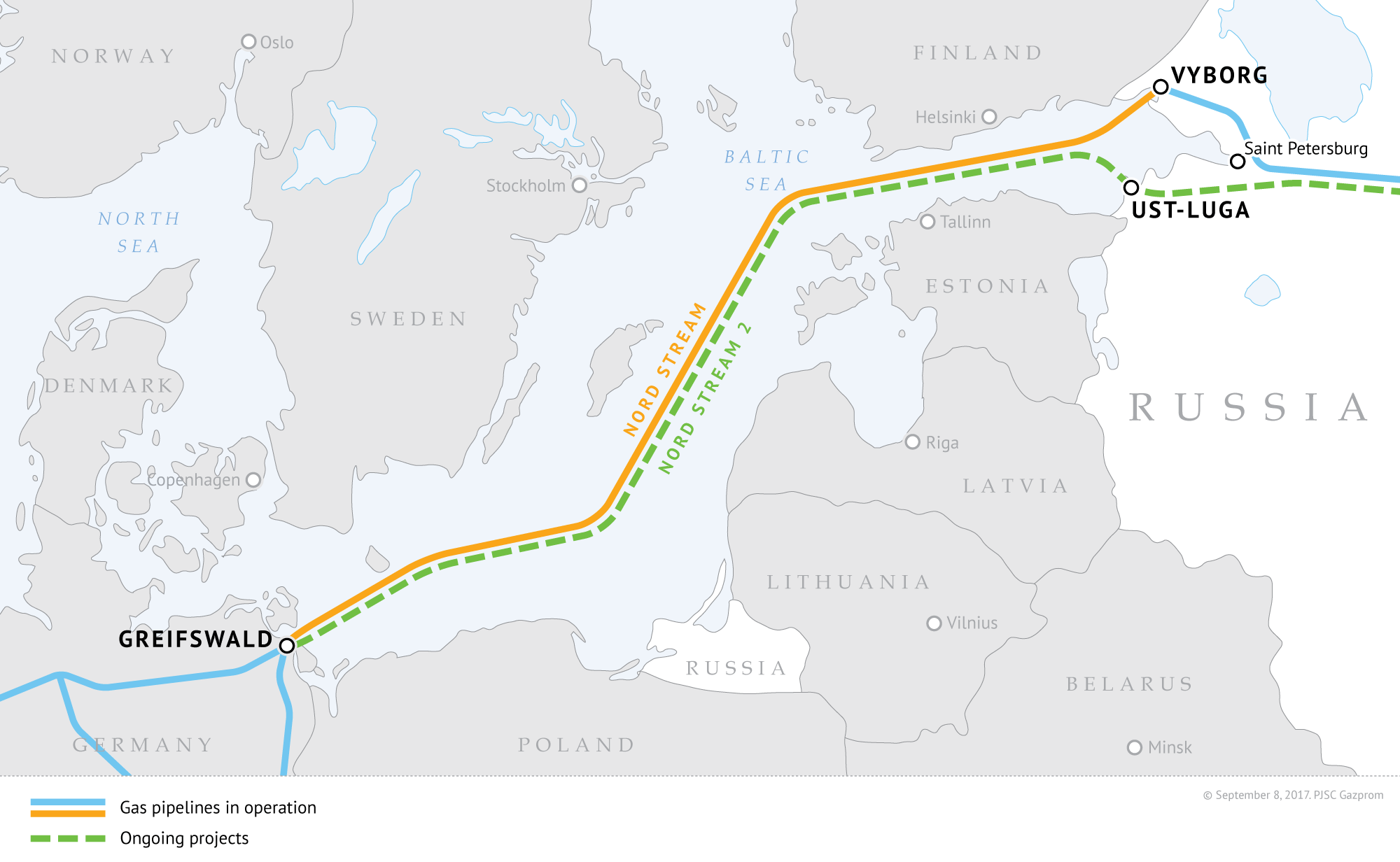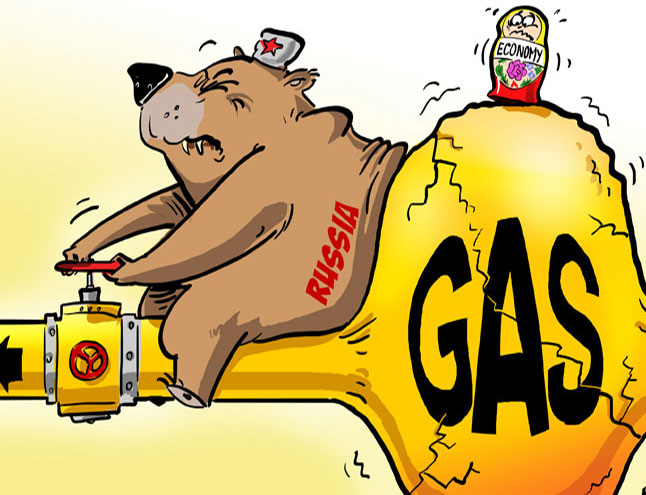
What happened?
Germany has greenlighted the construction of the Russian-controlled natural gas pipeline known as Nord Stream 2.
Denmark, Sweden, and Finland, the territorial waters of which the pipeline would traverse, have also given their consent to laying the projected two new lines at the bottom of the Baltic Sea.
Why should I care?
Russia consistently uses gas exports as a tool of political pressure and the new pipeline will make the EU vulnerable to Russian geopolitical blackmail.
In fact, almost all Eastern and Southeastern European countries and the Baltic states suffered from Gazprom’s policy, according to the leaked report by the European Commission’s Directorate-General for Competition.
For example, Poland paid Gazprom $350 per 1,000 cubic meters of gas, while the price for Germany was $200. Experts say that the fair price for Poland would have been about $175-180, but Gazprom charged the country double to punish the Poles for refusing to sell their gas transportation system to Russian.


The average annual transit of Russian natural gas to European customers through the Ukrainian gas transmission system has reached 93.5 billion cubic meters in 2017. If two Russian projects, Nord Stream 2 and Turkish Stream will be implemented, Gazprom will have the opportunity to significantly reduce the volume of gas transit through Ukraine as early as 2020. NS2 will expand Nord Stream’s capacity to 110 billion cubic meters per year, Turkish Stream will add another 16 billion cubic meters.
Having Nord Stream 2 built and therefore lacking any need for the Ukrainian gas transit system, Russia will lose an important incentive to avoid further escalation of its military aggression against Ukraine and its hybrid war with Europe and the United States.
Why is it called Nord Stream 2? Is there a Nord Stream 1?
Nord Stream is an operating offshore sub-sea natural gas pipeline including two parallel lines inaugurated in 2011-2012. It has an annual capacity of 55 billion cubic meters. Nord Stream 2 is a project to twin Nord Stream 1 and to double its total flow efficiency to 110 billion cubic meters.

Russia plans to build 866 kilometers of new pipeline and three compressor stations, additionally, it’s going to expand five existing stations for feeding Nord Stream 2. The route of the two additional sub-sea pipelines would mainly follow the existing lines.
- Nord Stream 2 is planned to be 1,200km long with a diameter of 1.153m
- The line will pass through territorial waters of Russia, Finland, Sweden, Denmark, and Germany.
- The pipeline is designed to last at least 50 years.
Who is building Nord Stream 2?
The declaration to build two new pipelines through the Baltic Sea (later named Nord Stream 2) was signed by Russia’s Gazprom and its European partners (BASF, E.ON, Engie, OMV, and Shell) back in September 2015.
Nord Stream is owned and operated by Nord Stream AG, a consortium shared by Gazprom (51%) and four European energy companies. Gazprom is a Russian state-controlled natural gas monopoly.
Nord Stream 2 is being developed as a consortium led by Gazprom (50%), with partnerships from European companies – E.ON (10%), OMV (10%), Shell (10%), Wintershall (10%), and ENGIE (10%).
Why is Nordstream 2 being built in the first place?
About a third of Europe’s gas comes from Russia and the Kremlin hopes to expand Europe’s gas dependency using its lobbyists in the EU to push the project which would make the EU more reliant on Gazprom in future.
Who lobbies for Nord Stream 2 construction in the EU?
Gazprom’s major lobbyist in Europe is former German Chancellor Gerhard Schröder, the chairman of the board of Nord Stream AG and of Rosneft. Other backers of the project are several Gazprom’s partner companies in Europe, including BASF, Engie, OMV.
In July-September 2017 alone, developer of Nord Stream 2 AG spent at least $880,000 on lobbying efforts in Washington to promote the implementation of the project in the face of a new set of US sanctions.
The significant group of NS2 lobbyists is the European companies involved in the project, including Uniper, Wintershall, Engie, OMV, Royal Dutch Shell, and BASF. Particularly in Germany, the list of the Kremlin allies is long.
Who’s against Nordstream 2?
Ukraine, the Baltic States, Poland, and the USA are the most vocal critics of the NS2. The project has also been criticized by the EU bodies, particularly by the European Commission and European Parliament, both of which oppose the project.
In March 2016, leaders of nine EU countries – the Czech Republic, Estonia, Hungary, Latvia, Poland, Slovakia, Romania, and Lithuania – signed a letter to the European Commission, warning that the Nord Stream 2 project contradicts the EU energy policy requirements.
This January, then-Secretary of State Rex Tillerson said that “the United States opposes the Nord Stream 2 pipeline,” according to him, the US sees “it as undermining Europe’s overall energy security and stability and providing Russia yet another tool to politicize energy as a political tool.”
And on 9 May 2018, Poland’s antitrust watchdog launched legal proceedings against Gazprom and five other companies financing Nord Stream 2, citing concerns the project would hamper competition on the nation’s gas market. German environmentalists from the NABU NGO have on 11 May launched legal proceedings too: they claim the construction of the pipeline will harm the fragile ecosystem of Greifswald Bodden and have requested that a German court issues a decree to stop the construction.. And on 12 May, Polish environmentalists from ClientEarth Foundation have taken legal action as well: they appeal to the Finnish administrative court to repeal Finland’s decision to agree to build the pipeline, claiming that the environmental assessment of the Finnish section of the pipeline is incorrect and based on erroneous data given by the investor.
Last year, the US Congress empowered President Trump to impose sanctions against Nord Stream 2, but he hasn’t used that option so far. However, in March, the US included Alexei Miller, the CEO of Gazprom on an expanded economic sanctions list.
What’s wrong with a little diversification of gas supplies?
Nord Stream 2 doesn’t provide access to any new gas sources: the same Russian gas will be supplied by the same company, Gazprom. But NS2 will undermine the access of Central and Eastern European countries to non-Gazprom suppliers from the West, thus reversing most of the region’s supply diversification efforts.
Director-General of the European Commission’s Energy Directorate, Dominique Ristori said that if Nord Stream 2 goes ahead, the Commission will not support it, he stated, “We believe that Nord Stream 2 does not promote diversification of deliveries and delivery routes. When the pipeline is built, it will not be supported by the EU, and especially not by the European Commission.”
Poland and Lithuania, vehement critics of Nord Stream 2, have earlier built LNG terminals. Poland took delivery of the first US shipment of LNG to Europe last year, and US President Donald Trump said then that he wants to boost LNG exports to Europe.
In his comment to Euromaidan Press, Kyiv-based energy expert Mykhaylo Honchar highlighted that the Trans-Anatolian gas pipeline (TANAP) being constructed to bring Azerbaijani gas via Georgia and Türkiye to Europe can’t undermine Gazprom’s domination in the European natural gas market because of its insignificant capacity (16 billion cubic meters per year against 110 projected for both Nord Streams). To diversify the gas sources, the EU could boost gas supplies from the Caspian region, particularly from Turkmenistan, by either building a new more capable pipeline or even using the Russian and Ukrainian ones as transportation systems. But, as Mr. Honchar believes, Brussels doesn’t seem to be interested in such projects.
So has the construction of the Nordstream 2 pipeline been green-lighted?
It is. Germany promises that the project can only go ahead if Ukraine’s role as a transit country for Russian gas is protected. Moreover, some construction work has started already.
As far as Russia would benefit from eroding Ukraine’s transit role, the reliability of any Russian promises remains questionable.
In the past, Ms. Merkel called Nord Stream 2 a purely “economic project” with no need for political intervention, now she admits that “it is not just an economic issue but there are also political considerations.”
Germany has already started the construction works on 3 May 2018 in its Baltic Sea port of Lubmin, before Sweden and Finland approved the pipeline running through their waters, and despite the opposition of the European Commission and European Parliament.
How can its construction be prevented?
The EU can still block the project. Another option to prevent the NS2 construction may be the US sanctions against companies that would be involved in the project in case if the US sanctions will be supported by the EU. However, no plans for sanctions have been voiced by the US yet.
Read more:
- How Ukraine can protect itself from Nord Stream 2
- Russia’s March-2018 gas war attempt against Ukraine, explained
- Putin’s plans to destroy Ukraine’s gas transit system
- Nordstream2 opens road for Russian offensive in Ukraine, subjects EU to gas wars – Energy panel at Kyiv Security Forum
- Why German politicians want to make peace with Putin
- The secret Soviet council which established the Kremlin’s gas monopoly on Europe







